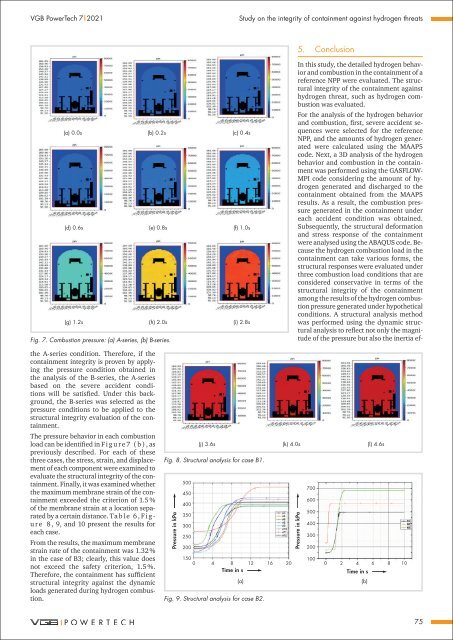VGB POWERTECH 7 (2021) - International Journal for Generation and Storage of Electricity and Heat
VGB PowerTech - International Journal for Generation and Storage of Electricity and Heat. Issue 7 (2021). Technical Journal of the VGB PowerTech Association. Energy is us! Optimisation of power plants. Thermal waste utilisation.
VGB PowerTech - International Journal for Generation and Storage of Electricity and Heat. Issue 7 (2021).
Technical Journal of the VGB PowerTech Association. Energy is us!
Optimisation of power plants. Thermal waste utilisation.
- No tags were found...
Create successful ePaper yourself
Turn your PDF publications into a flip-book with our unique Google optimized e-Paper software.
<strong>VGB</strong> PowerTech 7 l <strong>2021</strong><br />
Study on the integrity <strong>of</strong> containment against hydrogen threats<br />
5. Conclusion<br />
(a) 0.0s (b) 0.2s (c) 0.4s<br />
(d) 0.6s (e) 0.8s (f) 1.0s<br />
(g) 1.2s (h) 2.0s<br />
(i) 2.8s<br />
Fig. 7. Combustion pressure: (a) A-series, (b) B-series.<br />
In this study, the detailed hydrogen behavior<br />
<strong>and</strong> combustion in the containment <strong>of</strong> a<br />
reference NPP were evaluated. The structural<br />
integrity <strong>of</strong> the containment against<br />
hydrogen threat, such as hydrogen combustion<br />
was evaluated.<br />
For the analysis <strong>of</strong> the hydrogen behavior<br />
<strong>and</strong> combustion, first, severe accident sequences<br />
were selected <strong>for</strong> the reference<br />
NPP, <strong>and</strong> the amounts <strong>of</strong> hydrogen generated<br />
were calculated using the MAAP5<br />
code. Next, a 3D analysis <strong>of</strong> the hydrogen<br />
behavior <strong>and</strong> combustion in the containment<br />
was per<strong>for</strong>med using the GASFLOW-<br />
MPI code considering the amount <strong>of</strong> hydrogen<br />
generated <strong>and</strong> discharged to the<br />
containment obtained from the MAAP5<br />
results. As a result, the combustion pressure<br />
generated in the containment under<br />
each accident condition was obtained.<br />
Subsequently, the structural de<strong>for</strong>mation<br />
<strong>and</strong> stress response <strong>of</strong> the containment<br />
were analysed using the ABAQUS code. Because<br />
the hydrogen combustion load in the<br />
containment can take various <strong>for</strong>ms, the<br />
structural responses were evaluated under<br />
three combustion load conditions that are<br />
considered conservative in terms <strong>of</strong> the<br />
structural integrity <strong>of</strong> the containment<br />
among the results <strong>of</strong> the hydrogen combustion<br />
pressure generated under hypothetical<br />
conditions. A structural analysis method<br />
was per<strong>for</strong>med using the dynamic structural<br />
analysis to reflect not only the magnitude<br />
<strong>of</strong> the pressure but also the inertia ef-<br />
the A-series condition. There<strong>for</strong>e, if the<br />
containment integrity is proven by applying<br />
the pressure condition obtained in<br />
the analysis <strong>of</strong> the B-series, the A-series<br />
based on the severe accident conditions<br />
will be satisfied. Under this background,<br />
the B-series was selected as the<br />
pressure conditions to be applied to the<br />
structural integrity evaluation <strong>of</strong> the containment.<br />
The pressure behavior in each combustion<br />
load can be identified in F i g u r e 7 ( b ) , as<br />
previously described. For each <strong>of</strong> these<br />
three cases, the stress, strain, <strong>and</strong> displacement<br />
<strong>of</strong> each component were examined to<br />
evaluate the structural integrity <strong>of</strong> the containment.<br />
Finally, it was examined whether<br />
the maximum membrane strain <strong>of</strong> the containment<br />
exceeded the criterion <strong>of</strong> 1.5 %<br />
<strong>of</strong> the membrane strain at a location separated<br />
by a certain distance. Ta b l e 6 , F i g -<br />
u r e 8 , 9, <strong>and</strong> 10 present the results <strong>for</strong><br />
each case.<br />
From the results, the maximum membrane<br />
strain rate <strong>of</strong> the containment was 1.32 %<br />
in the case <strong>of</strong> B3; clearly, this value does<br />
not exceed the safety criterion, 1.5 %.<br />
There<strong>for</strong>e, the containment has sufficient<br />
structural integrity against the dynamic<br />
loads generated during hydrogen combustion.<br />
(j) 3.6s (k) 4.0s (l) 4.6s<br />
Fig. 8. Structural analysis <strong>for</strong> case B1.<br />
500<br />
700<br />
450<br />
600<br />
400<br />
Pressure in kPa<br />
350<br />
300<br />
250<br />
200<br />
150<br />
100<br />
0 4 8 12 16 20 0 2 4 6 8 10<br />
Time in s<br />
Time in s<br />
(a)<br />
(b)<br />
Fig. 9. Structural analysis <strong>for</strong> case B2.<br />
Pressure in kPa<br />
500<br />
400<br />
300<br />
200<br />
75


















